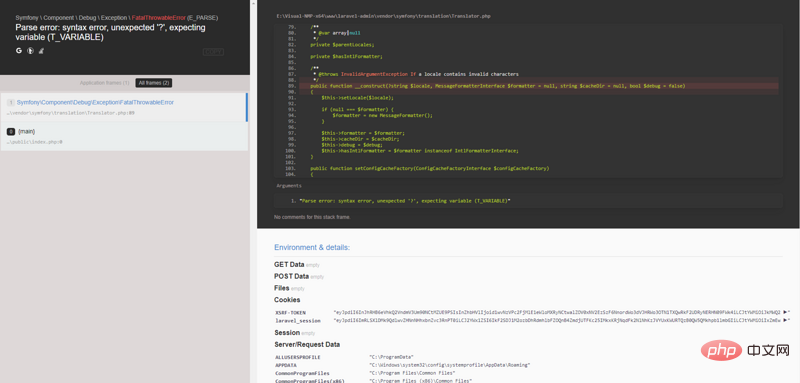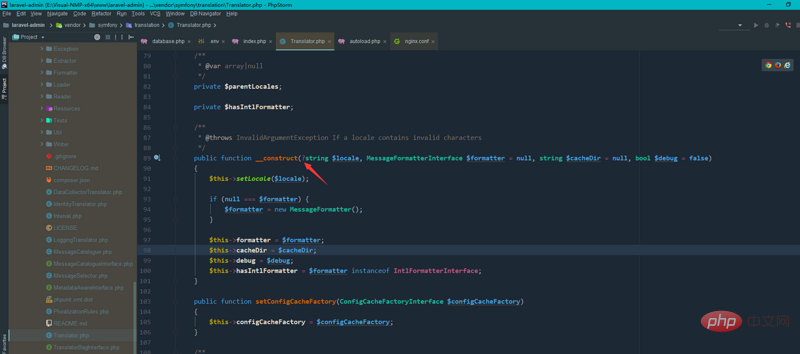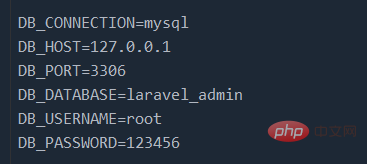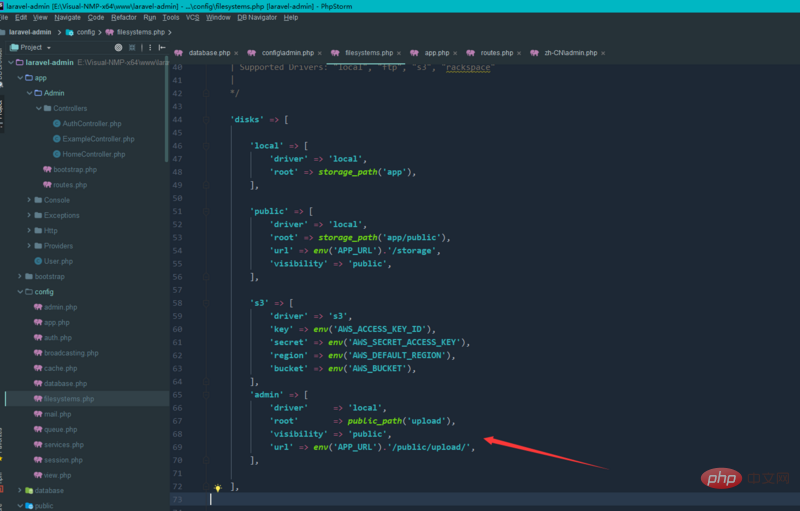Introduction to the installation steps of laravel5.5 and laravel-admin
This article brings you an introduction to the installation steps of laravel5.5 and laravel-admin. It has certain reference value. Friends in need can refer to it. I hope it will be helpful to you.
Configuring laravel-admin
The official tutorial is still no problem, but I also encountered a little pitfall, let’s make a record again
Installing Laravel
Laravel uses Composer to manage dependencies, so make sure Composer is installed on the machine before installation (if it is not installed yet, refer to this document to install it).
Through the Laravel installer
First, install the Laravel installer through Composer:
composer global require "laravel/installer"
Make sure $HOME/.composer/vendor/bin is in the system path (corresponding to Mac The path is ~/.composer/vendor/bin, and the Windows corresponding path is ~/AppData/Roaming/Composer/vendor/bin, where ~ represents the current user's home directory), otherwise the laravel command cannot be called in any path on the command line.
After the installation is complete, you can create a new Laravel application in the current directory with a simple laravel new command. For example, laravel new blog will create a new application named blog and include all Laravel dependencies. . This installation method is much faster than installing through Composer:
laravel new blog
If you have installed an old version of Laravel installer before, you need to update it before you can install the latest Laravel 5.5 framework application:
composer global update
Pass Composer Create-Project
You can also install Laravel applications through Composer's create-project command in the terminal:
composer create-project --prefer-dist laravel/laravel laravel-admin
If you want to download and install other versions of Laravel applications, such as version 5.5, you can use This command:
composer create-project --prefer-dist laravel/laravel laravel-admin 5.5.*。
Note
PHP7.0.30 error is reported, the document says PHP>7.0.0 is enough, but this way of writing seems to be only possible for 7.1.


## This way of writing is not recognized, just remove it OK. Or upgrade to a higher version of PHP. Pay attention to open the openssl
.env file and follow the regular configuration
Be careful not to write the wrong database table name
ThenFirst make sure laravel is installed and the database connection is set correctly. Then enter the laravel directory and executecomposer require encore/laravel-admin
php artisan vendor:publish --provider="Encore\Admin\AdminServiceProvider"
php artisan admin:install

 ##Finally Enter config/filesystems.php and add
##Finally Enter config/filesystems.php and add
'admin' => [
'driver' => 'local',
'root' => public_path('upload'),
'visibility' => 'public',
'url' => env('APP_URL').'/public/upload/',
], Modify language:
Modify language:
'locale' => 'zh-CN',
The above is the detailed content of Introduction to the installation steps of laravel5.5 and laravel-admin. For more information, please follow other related articles on the PHP Chinese website!

Hot AI Tools

Undresser.AI Undress
AI-powered app for creating realistic nude photos

AI Clothes Remover
Online AI tool for removing clothes from photos.

Undress AI Tool
Undress images for free

Clothoff.io
AI clothes remover

Video Face Swap
Swap faces in any video effortlessly with our completely free AI face swap tool!

Hot Article

Hot Tools

Notepad++7.3.1
Easy-to-use and free code editor

SublimeText3 Chinese version
Chinese version, very easy to use

Zend Studio 13.0.1
Powerful PHP integrated development environment

Dreamweaver CS6
Visual web development tools

SublimeText3 Mac version
God-level code editing software (SublimeText3)

Hot Topics
 1386
1386
 52
52
 Laravel Eloquent ORM in Bangla partial model search)
Apr 08, 2025 pm 02:06 PM
Laravel Eloquent ORM in Bangla partial model search)
Apr 08, 2025 pm 02:06 PM
LaravelEloquent Model Retrieval: Easily obtaining database data EloquentORM provides a concise and easy-to-understand way to operate the database. This article will introduce various Eloquent model search techniques in detail to help you obtain data from the database efficiently. 1. Get all records. Use the all() method to get all records in the database table: useApp\Models\Post;$posts=Post::all(); This will return a collection. You can access data using foreach loop or other collection methods: foreach($postsas$post){echo$post->
 The Future of PHP: Adaptations and Innovations
Apr 11, 2025 am 12:01 AM
The Future of PHP: Adaptations and Innovations
Apr 11, 2025 am 12:01 AM
The future of PHP will be achieved by adapting to new technology trends and introducing innovative features: 1) Adapting to cloud computing, containerization and microservice architectures, supporting Docker and Kubernetes; 2) introducing JIT compilers and enumeration types to improve performance and data processing efficiency; 3) Continuously optimize performance and promote best practices.
 PHP vs. Python: Understanding the Differences
Apr 11, 2025 am 12:15 AM
PHP vs. Python: Understanding the Differences
Apr 11, 2025 am 12:15 AM
PHP and Python each have their own advantages, and the choice should be based on project requirements. 1.PHP is suitable for web development, with simple syntax and high execution efficiency. 2. Python is suitable for data science and machine learning, with concise syntax and rich libraries.
 PHP's Current Status: A Look at Web Development Trends
Apr 13, 2025 am 12:20 AM
PHP's Current Status: A Look at Web Development Trends
Apr 13, 2025 am 12:20 AM
PHP remains important in modern web development, especially in content management and e-commerce platforms. 1) PHP has a rich ecosystem and strong framework support, such as Laravel and Symfony. 2) Performance optimization can be achieved through OPcache and Nginx. 3) PHP8.0 introduces JIT compiler to improve performance. 4) Cloud-native applications are deployed through Docker and Kubernetes to improve flexibility and scalability.
 PHP and Python: Comparing Two Popular Programming Languages
Apr 14, 2025 am 12:13 AM
PHP and Python: Comparing Two Popular Programming Languages
Apr 14, 2025 am 12:13 AM
PHP and Python each have their own advantages, and choose according to project requirements. 1.PHP is suitable for web development, especially for rapid development and maintenance of websites. 2. Python is suitable for data science, machine learning and artificial intelligence, with concise syntax and suitable for beginners.
 Laravel's geospatial: Optimization of interactive maps and large amounts of data
Apr 08, 2025 pm 12:24 PM
Laravel's geospatial: Optimization of interactive maps and large amounts of data
Apr 08, 2025 pm 12:24 PM
Efficiently process 7 million records and create interactive maps with geospatial technology. This article explores how to efficiently process over 7 million records using Laravel and MySQL and convert them into interactive map visualizations. Initial challenge project requirements: Extract valuable insights using 7 million records in MySQL database. Many people first consider programming languages, but ignore the database itself: Can it meet the needs? Is data migration or structural adjustment required? Can MySQL withstand such a large data load? Preliminary analysis: Key filters and properties need to be identified. After analysis, it was found that only a few attributes were related to the solution. We verified the feasibility of the filter and set some restrictions to optimize the search. Map search based on city
 Laravel and the Backend: Powering Web Application Logic
Apr 11, 2025 am 11:29 AM
Laravel and the Backend: Powering Web Application Logic
Apr 11, 2025 am 11:29 AM
How does Laravel play a role in backend logic? It simplifies and enhances backend development through routing systems, EloquentORM, authentication and authorization, event and listeners, and performance optimization. 1. The routing system allows the definition of URL structure and request processing logic. 2.EloquentORM simplifies database interaction. 3. The authentication and authorization system is convenient for user management. 4. The event and listener implement loosely coupled code structure. 5. Performance optimization improves application efficiency through caching and queueing.
 PHP: The Foundation of Many Websites
Apr 13, 2025 am 12:07 AM
PHP: The Foundation of Many Websites
Apr 13, 2025 am 12:07 AM
The reasons why PHP is the preferred technology stack for many websites include its ease of use, strong community support, and widespread use. 1) Easy to learn and use, suitable for beginners. 2) Have a huge developer community and rich resources. 3) Widely used in WordPress, Drupal and other platforms. 4) Integrate tightly with web servers to simplify development deployment.




